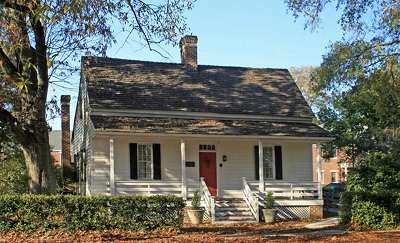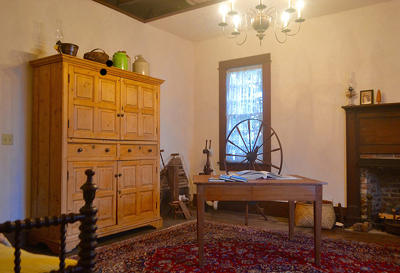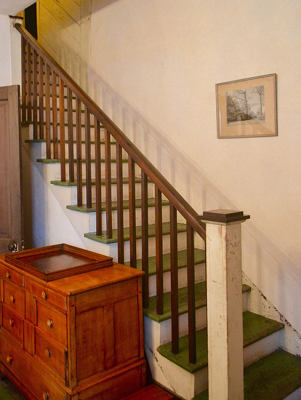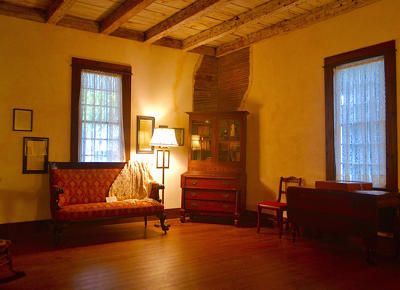Hartsville Plantation – Hartsville – Darlington County
Basic Information
- Location – Downtown Hartsville, Darlington County
106 E. Home Avenue (4, p. 1)
- Origin of name – Hartsville, the town and plantation, were named for Captain Thomas E. Hart (1, p. 1)
- Other names – Hart-Mills Cottage
- Current status – The plantation's property has been subdivided over the years in the development of downtown Hartsville. The plantation's house still stands and is owned by the Hartsville Heritage Foundation (4, p. 1).
Timeline
- 1845 – Earliest known date of existence (2)
John Lide Hart purchased 491 acres of Kalmia Plantation from his brother-in-law Colonel Thomas C. Law. Kalmia Plantation had been owned by John Lide Hart's father, Captain Thomas E. Hart. Captain Hart fell on hard times and had sold part of the plantation in the late 1830s to Law, his son-in-law (1, p. 1) (2).
- Circa 1850 – House built (4, p. 2)
John Lide Hart constructed a one-and-a-half-story frame cottage for his residence. It is believed to be the first house constructed within the original boundaries of the town. He also built a carriage factory, sawmill, grist mill store, post office, school and Hartsville Baptist Church, today called First Baptist Church of Hartsville on the plantation's property (1, p. 1) (2) (4, p. 3).
- 1854 – John Lide Hart fell on hard financial times which lead to him selling the plantation and its business ventures to Caleb Coker. Hart then moved to Darlington, started a carriage factory there, and built a larger house which is now called the Goodson House (4, p. 6).
- 1858 – Caleb Coker gave his son, Major James Lide Coker, half of the plantation, which included the cottage, when James returned from attending Harvard. Like the plantation's founder, James Coker developed a variety of businesses on his Hartsville property. Among them was the Southern Novelty Company which is now known as the global company Sonoco (4, p. 6) (7).
Major Coker never lived in the house but rented it over the years. Many families prominent to the history of Hartsville began married life in the house, which lead to locals calling it the "Honeymoon Cottage." Read an article written by one of these honeymoon residents at SCIWAY – Hart-Mills Cottage.
- 1918 – James Lide Coker died and his granddaughter became owner of the house. She continued to rent out the house, including almost a decade to her brother, Edgar Lawton (4, p. 7).
- 1934 – Dr. James E. Mills purchased the house. Dr. Mills was a noted chemist that moved to Hartsville to work with Sonoco (4, p. 7).
- 1973 – Dr. Mills passed away in 1950 but his widow, Mary Mills, lived in the house until this year (4, p. 7).
- 1974 – First Baptist Church acquired the plantation house (4, p. 2).
- 1981 – The Hartsville Heritage Foundation acquired the house. The house was moved approximately 55' from its original location and restored (4, p. 2).
Land
- Number of acres – 491 in 1845; .15 acres in 1983 (2) (4, p. 4)
- Primary crop – Cotton and corn after the Civil War (7)
Slaves
- Number of slaves – ?
References & Resources
Many thanks to Cyndi Shull for contributing all of the following resources:- Hartsville, The Art of Good Living - PDF brochure
- Hartsville, South Carolina - Project Gutenberg Self-Publishing Press
- Ernest Henry Wilson and Alfred Rehder, A Monograph of Azaleas: Rhododendron Subgenus Anthodendron (Boston, MA: Harvard University Press, 1921), p. 150
- National Register of Historic Places
– Nomination form - PDF - submitted in 1983
– Photographs, architectural overview
- Ardie Arvidson, Hartsville's Historic Homes Ready For Open House, (Hartsville, SC: The Hartsville Messenger, December 3, 2014)
- W.C. Coker, Ph.D., The Plant Life of Hartsville, S.C., (Columbia, SC: The State Co., 1912)
- Donna Thorne, Hartsville: The Heart of the Pee Dee, (Columbia, SC: Sandlapper Magazine, Winter, 2010)






